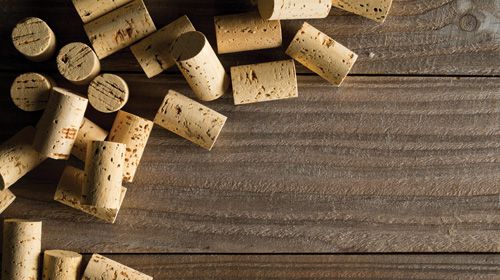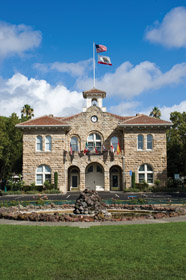A gleaming bottle of fine wine with a perfect, natural cork has a special mystique. And while the wine within is the primary focus, the cork has a vital role, too. The distinctive pop that goes with opening a lovely effervescent sparkling wine is synonymous with special occasions, and uncorking a bottle of a still varietal is part of the ritual that goes with the first sip. And so, as small as a cork might be, it adds immeasurably to the experience, as well as fulfilling its most important purpose—sealing a bottle to preserve a wine while allowing its qualities to develop.
A cork’s use as a closure for wine has a long history, going back centuries. Archaeologists found amphorae (ceramic jars with slim necks) of wine sealed with corks in the ruins of ancient Pompeii, which Italy’s Mount Vesuvius buried in lava and ash in a volcanic eruption in A.D. 79. Excavations at Ephesus in ancient Greece—now part of Turkey—also uncovered amphorae sealed with cork that date to the first century. Other stoppers were stone covers and rags soaked in oil, and the widespread use of cork only came about in the 1800s, when glass bottles became the standard in Europe for storing and transporting wine. The search for an ideal closure led to cork, but even so, it took until the 21st century for cork to gain recognition as the quintessential seal for wine and a product with near-magical properties. It’s the rare natural substance that’s soft, durable, buoyant, mold-resistant and fireproof, making it ideal for purposes as varied as fishing equipment, insulation for the space shuttle and fashionable handbags.
Harvesting
Cork is derived from the bark of the cork oak tree, quercus suber, a medium-sized evergreen, and the first forests were in Portugal, which enacted environmental laws to protect them in the 13th century. It took much longer for substantial cultivation to begin, however, with the increasing demand for wine stoppers the principal motivation. France, Italy and Tunisia planted trees in the 19th century, and Algeria, Morocco and Spain following, making seven Mediterranean countries the major producers of cork.
Greek philosopher Theophrastus commented on the cork oak’s ability to grow new bark in his botanical works in the fourth century, and that characteristic is what makes the tree unique. Every nine years, agricultural workers carefully strip the bark using a special axe and leave the trees standing so new bark can grow. It takes nine years for trees to grow enough bark for the next harvest, and stripping it any earlier is strictly forbidden, even if a tree appears ready. Young trees have to grow almost 50 years before the bark is thick enough for corks, making them a long-term investment, but the average life span is 200 years, allowing several harvests. “Cork harvesting is completely counterintuitive to the way we think about forestry, “ says Patrick Spencer, founder and executive director of Cork Forest Conservation Alliance. He compares the process to shearing a sheep. Just as farmers take the wool without harming the animal, removing the bark doesn’t damage the tree. Family farmers own most of the forests, and harvesting the trees requires precision and skill. As a result, the harvesters are some of the highest paid and skilled agricultural workers in the EU. “This is really local, community-based family farming at its best,” Spencer observes.
Testing
California’s Wine Country suppliers get their corks from Portugal, where producers manufacture the stoppers and put them through their first round of testing for quality control. First, the cork strips are pressed, and then a machine based on a design patented in the United Kingdom in the 19th century punches the individual corks from the compressed strips. Then, after they pass the tests, they’re shipped to buyers around the world. “We purchase from several suppliers in Portugal that we have been purchasing from for many years,” says Chris Holman, general manager of the packaging department at Scott Laboratories in Petaluma. Scott labs receives corks in bales of either 5,000 or 10,000, and when they receive them, they subject them to a rigorous testing process, which is standard industry practice. “We not only test in Portugal, but also again when it arrives here,” says Holman, explaining that they test for presence of TCA (trichloranisole), a natural compound that can give wine, as well as other food and beverages, a musty flavor and aroma. “If it doesn’t pass our strict testing protocols for TCA and visual quality, we send the cork back to Portugal,” he says. “Being independent is important, as we can reject any lots that don’t meet our standards, ensuring that everything we receive is very clean to begin with,” he says. “We don’t pay for the cork until it passes our strict QC protocols, so we have the flexibility to scrutinize each lot.”
Neil Foster, president of MASilva USA in Santa Rosa, explains that a good, clean cork won’t impart any unpleasant flavors to the wine and will create an optimal seal to prevent oxidization and reduction. MASilva offers corks sourced from its partner company MASilva Portugal, as well as bottles using proprietary molds. “By providing both, we’re providing the perfect fit for your wine,” he says, explaining that the neck diameters are very tightly controlled and provide the best seals for the cork. MASilva also conducts tests on all corks and bottle deliveries. “Once we receive the cork in Santa Rosa, we undertake a number of tests to make sure the integrity is good and they meet all quality standards,” he adds. Among them is a visual inspection to determine the correct visual quality for each individual quality level. Higher quality corks have smaller lenticels (the raised pores in the wood) and a smoother surface, so when a winery’s name is printed on the cork, it’s sharper. The company also tests for TCA by soaking a sample of corks in wine and then sending the wine for testing to ETS Labs in St. Helena, which does an independent analysis in accordance with Cork Quality Council standards. MASilva audits each lot as well to insure that the cork is above the acceptable level for sale to wineries. “As a manufacturer and distributor, we source the best and cleanest,” says Foster.
New methods
Amorim Cork America, located in Napa, is affiliated with Corticeira Amorim, an international company with headquarters in Portugal and the largest producer of wine corks in the world. Like all other local cork suppliers, its testing begins in Portugal, where the corks go through a state-of-the-art individual screening system called NDtech, which uses chromatography and can detect TCA at 0.5 parts per trillion. Vance Rose, director of sales and marketing, explains that TCA volatizes above 60˚F, and the process involves putting the corks into a chamber, heating them to a range of 60 to 62˚F to separate the components and then using a gas chromatography machine to identify them. The process takes seconds, and its detection of TCA is the equivalent of finding one drop of water in 800 Olympic-sized swimming pools. Amorim has screened more than 80 million corks for distribution around the world, and so far, most of them have been for still wine. However, it has started to run corks for sparkling wine through the system as well. Amorim also tests to make sure corks will seal a bottle of wine by applying air pressure to one end of a cork and monitoring the other end to see if any air comes out.
Testing continues once the corks reach Napa. “We have a lab here, and we test all our incoming corks, and we do what we call a military standard,” says Rose. It includes analysis for TCA, sensorial analysis and grading the corks visually. If the corks pass, they undergo a physical properties test, which involves weighing 50 corks, checking the length and diameter, the internal moisture and making sure that they’re round, not oval. “If it fails any of those, we send them back to Portugal,” says Rose, explaining that they’re either retreated or ground up so they can be used for other purposes. “We are only cork. That is all we have to sell,” he says. “If we’re not good at it, we’re out of business.”
Taint
Though testing for TCA is an exacting science, dispelling the notion that cork is the only possible culprit for tainted wine is a challenge. Peter Weber of the Cork Quality Council in Forestville explains that wine is a perfect medium for presenting TCA, because it has enough alcohol to draw it from the cork and enough water to make it volatile in the air. “If you have some TCA in the cork, it will dissipate into the wine,” he says. He describes the resulting odor as a musty, wet newspaper kind of smell. “When you smell wet newspaper, you smell TCA. I’ve also smelled TCA in carrots and apples. It’s fairly common,” he says. With the goal of reducing the incidence of contaminated corks, the Cork Quality Council took on the task of developing standard methods for testing several years ago. “Our industry required a solution that all members held to,” says Weber, pointing out that a tainted cork has a damaging effect that goes beyond the supplier. “A consumer would never ask which company a cork came from,” he observes. Working together, the council and ETS Labs spent a year and a half doing research, and they developed a chemical method using gas chromatography that detects TCA at levels as low as one part per trillion. Weber believes that TCA now occurs at a rate well below 1 percent. He finds that the number of tainted corks is often exaggerated, and the misinformation is the result of outdated information from 15 years ago or more, when the presence of TCA in corks was more prevalent. Now, the incidence of tainted corks is significantly lower. “If we do see TCA at our level of notification, we reject the entire lot of corks,” he says “In some types of cork, we haven’t seen one part per trillion in a year and a half,” he reports. CQC members conduct 30,000 tests a year. “We’ve spent quite a lot of time and testing. We’ve probably spent $1.5 million a year testing for TCA,” he says. “That’s why we’ve seen such an improvement in quality.”
Weber observes that some people use “cork taint” as a catchall phrase for anything that gives wine an unexpected flavor, and he finds it an odd name. “Haloanisole taint is a better description,” he says. Haloanisoles are a family of volatile chemical compounds, and TCA is just one of them. They can be found in wood as well as wine, and even at two parts per trillion, most people would never notice them. Though our testing focuses on cork, it isn’t the only source. Haloanisoles can be found in barrels and filtration components, and Weber reports that they can even occur in the walls of wine cellars, although most wineries are aware of the problem and have taken measures to guard against them.
Closure
The goal is to preserve the wine in the best way possible, and for some wineries that means turning to alternative closures that are available in the market. “My take is that there is a closure for all wines. … Everyone has their personal preference,” says Holman. “And that is why we carry a variety of quality closures to meet our customer’s needs.”
The choice often depends on the aging process. Weber explains that screw caps have optional liners to allow air to permeate into the wine, unlike the performance with a natural cork. The permeable membranes let in air for a cap’s lifetime as a closure. “Corks allow a small amount of oxygen to enter the wine by diffusion through the millions of tiny cells that are compressed when the cork is inserted into the bottle,” he says. “This diffusion takes place over a period of six to eight months. After that, oxygen transfer becomes negligible. So, for a cork-finished wine, the amount of oxygen transfer is roughly the same whether the wine is in the bottle for one year or three years. For wines finished with a permeable closure, oxygen transfer at three years would be roughly 300 percent greater than seen at one year.”
To find out how metal performs, Jordan Vineyard & Winery in Healdsburg bottled 10 cases of its 2001 Jordan Chardonnay with screw-caps so it could compare them to bottles of the same vintage closed with natural cork. Associate winemaker Maggie Kruse reports that every five years, they opened bottles of each to evaluate the wine and concluded that oak-aged wines benefited more from cellar time with a cork and were more complex and expressive than those with a screw-cap.
“Winemaker Rob Davis and his staff unanimously preferred the natural cork closure based on aroma, bouquet and overall flavor profile,” she reports. The wine with a screw-cap tasted bright and crisp when it was released, but it didn’t demonstrate any positive development in aging. “After a few years in the bottle, the screw-cap wine lacked the vibrancy,” she says, explaining that the evolution of a wine in the bottle is very important. “We find that natural cork is the best closure for our style of balanced French-inspired wines, which are meant to to be expressive and ready to drink while young, but age gracefully.”
Sustainability
Its ability to let wine age naturally is just one of the properties that makes cork popular. Another is its sustainability. Every bit of cork is usable, regardless of its grade. “We use 100 percent of everything,” says Rose. Some pieces are made into disks for agglomerated corks, and cork is also used for many products from flooring and insulation to surfboards. “We use every bit of bark we buy from the forest,” he says. Amorim even collects the dust and burns it as a source power in its primary facility in Portugal. In 2007, Corticeira Amorim received Forest Stewardship Council certification from the Rainforest Alliance and was the first to earn the honor for its work with forest owners to make the forests sustainable and convincing them to refrain from using chemicals. “One of the reasons we believe TCA exists is from the use of herbicides and pesticides,” says Rose. By not using them, he adds, the quality of the soil and the lives of the workers are better, as is the cork itself.
Corks can be recycled and repurposed, and Cork ReHarvest, which is a program of the Cork Forest Conservation Alliance, collected 21,000 pounds of cork from locations throughout the country in April through June of this year. “We’re bringing in 80 to 100 tons of cork every year,” says Spencer. He points out, however, that because cork is natural, recycling isn’t a priority. “You don’t have to recycle a natural cork. It’s made of wood. That cork is going to biodegrade. "Wine corks in landfills are not a bad thing, but the opportunity to eliminate this amount of waist, going into landfills is a great benefit,” he observes.
The cork forests also have environmental benefits. Each year, they sequester 20 million tons of CO2, provide oxygen to the atmosphere, and prevent desertification in this region of the world. They sequester carbon dioxide and put oxygen into the atmosphere, and they prevent the spread of deserts in arid regions. “We need to be investing in those forests, especially in North Africa, where the threat of desertification is most severe. Those cork forests are the last firewall,” Spencer explains. In addition, harvesting the bark instead of clear cutting doesn’t degrade the soil, affect the environment negatively or disrupt the biodiversity in forests that are rich with wildlife and a variety of species of plants.
Sustainability, its role in aging in wine and its abundance are all good reasons to use natural cork. For many people, it’s also about the image. Traditionally, world-class wines have been closed with natural cork, and it’s part of the experience and treasured memories. Add it all up, and cork is one of nature’s wonders.





